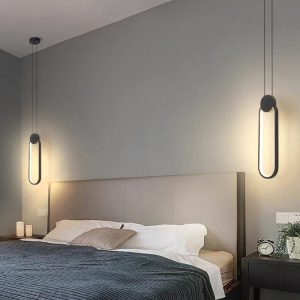
Shine a Light on Style: Elevate Your Space with Pendant Lighting
Pendant lighting is a type of lighting fixture that hangs from the ceiling by a cord, chain, or rod. It typically consists of a single light source enclosed in a decorative shade or glass globe. Pendant lighting has been used for centuries and has evolved over time to become a popular choice for both residential and commercial spaces.
The history of pendant lighting can be traced back to ancient civilizations such as the Egyptians and Greeks, who used oil lamps suspended from the ceiling to provide light in their homes and temples. In the 17th century, pendant lights became more ornate and were often made of expensive materials such as crystal or brass. In the 20th century, pendant lighting became more accessible to the general public with the introduction of mass production techniques.
There are several reasons why pendant lighting has become popular in modern interior design. Firstly, pendant lights provide focused lighting, making them ideal for task lighting in areas such as kitchen islands or dining tables. They can also be used to create ambient lighting in larger spaces such as living rooms or bedrooms. Additionally, pendant lights come in a wide variety of styles and designs, allowing homeowners to choose a fixture that complements their existing decor. Lastly, pendant lights are often more energy-efficient than traditional ceiling lights, making them a sustainable choice for environmentally-conscious individuals.
Key Takeaways
- Pendant lighting is a popular lighting fixture that hangs from the ceiling and adds both functionality and style to a room.
- The benefits of pendant lighting include its ability to provide focused lighting, its versatility in design, and its ability to save space.
- When choosing the right pendant light, factors to consider include the size and height of the room, the purpose of the light, and the style of the room.
- Pendant lighting styles range from modern to traditional, with options for every taste and decor.
- To incorporate pendant lighting into your home decor, consider using it as a statement piece or as a complement to existing lighting fixtures.
The Benefits of Pendant Lighting: Functionality and Style Combined
One of the main benefits of pendant lighting is its ability to provide focused lighting. Unlike ceiling lights that illuminate an entire room, pendant lights can be positioned directly over a specific area, such as a dining table or kitchen island. This makes them ideal for tasks that require concentrated light, such as cooking or reading. Pendant lights can also be used to create a focal point in a room, drawing attention to a particular area or object.
In addition to their functionality, pendant lights zomier also add style and character to a room. With a wide range of designs and materials available, homeowners can choose a pendant light that complements their existing decor and enhances the overall aesthetic of the space. Whether you prefer a modern, minimalist design or a more traditional, ornate fixture, there is a pendant light to suit every style.
Another advantage of pendant lighting is that it saves space. Unlike floor lamps or table lamps, pendant lights hang from the ceiling, freeing up valuable floor and surface space. This is particularly beneficial in smaller rooms or areas with limited space, where every square inch counts. Pendant lights can also be used to create the illusion of height in a room, making it feel more spacious and open.
Lastly, pendant lights are often more energy-efficient than traditional ceiling lights. Many pendant lights use LED bulbs, which consume less energy and have a longer lifespan than incandescent bulbs. This not only reduces energy consumption and lowers electricity bills but also reduces the environmental impact of lighting.
Choosing the Right Pendant Light: Factors to Consider
When choosing a pendant light for your home, there are several factors to consider to ensure you select the right fixture for your space.
Size and scale are important considerations when choosing a pendant light. The size of the room and the height of the ceiling will determine the appropriate size of the pendant light. A small pendant light may get lost in a large room with high ceilings, while a large pendant light may overwhelm a small room with low ceilings. It’s important to choose a pendant light that is proportionate to the size of the room and other furniture in the space.
The height and placement of the pendant light are also crucial factors to consider. The height at which the pendant light is hung will affect both its functionality and aesthetics. For example, if you are using a pendant light over a dining table, it should be hung at a height that allows for comfortable illumination without obstructing the view of the person sitting at the table. Similarly, if you are using a pendant light in a hallway or entryway, it should be hung at a height that allows for easy passage without hitting your head.
Style and design are also important considerations when choosing a pendant light. The style of the pendant light should complement the existing decor of the room and enhance its overall aesthetic. Whether you prefer a modern, minimalist design or a more traditional, ornate fixture, there is a pendant light to suit every style.
The material and finish of the pendant light should also be taken into account. Pendant lights are available in a wide range of materials, including metal, glass, wood, and fabric. The material and finish should not only match the style of the room but also be durable and easy to clean.
Lastly, the type of bulb and wattage should be considered when choosing a pendant light. LED bulbs are often the most energy-efficient option, consuming less energy and lasting longer than incandescent bulbs. The wattage of the bulb will depend on the desired level of brightness and the size of the room. It’s important to choose a bulb with the appropriate wattage to ensure adequate lighting without overpowering the space.
Pendant Lighting Styles: From Modern to Traditional
| Style | Description | Price Range | Popular Materials |
|---|---|---|---|
| Modern | Sleek and minimalistic designs with clean lines and geometric shapes. | 50-500 | Glass, metal, and plastic |
| Industrial | Rustic and raw designs inspired by factories and warehouses. | 75-700 | Metal, wood, and concrete |
| Transitional | A blend of traditional and modern styles with simple yet elegant designs. | 100-800 | Glass, metal, and fabric |
| Traditional | Ornate and decorative designs with classic shapes and intricate details. | 150-1000 | Glass, crystal, and metal |
Pendant lighting comes in a wide variety of styles, allowing homeowners to choose a fixture that suits their personal taste and complements their existing decor.
Modern and contemporary styles are characterized by clean lines, minimalistic designs, and sleek finishes. These pendant lights often feature geometric shapes and metallic accents, adding a touch of sophistication to any space. Modern pendant lights are ideal for minimalist interiors or spaces with a contemporary aesthetic.
Industrial and rustic styles are inspired by factories and warehouses, featuring raw materials such as metal and exposed bulbs. These pendant lights often have a vintage or distressed finish, adding a touch of nostalgia to any space. Industrial pendant lights are ideal for loft-style apartments or spaces with an industrial or rustic aesthetic.
Traditional and classic styles are characterized by ornate designs, intricate details, and luxurious materials. These pendant lights often feature crystal accents, fabric shades, and brass or gold finishes. Traditional pendant lights are ideal for formal living rooms or spaces with a traditional or classic aesthetic.
Art deco and vintage styles are inspired by the glamour of the 1920s and 1930s, featuring bold shapes, rich colors, and luxurious materials. These pendant lights often have a retro or antique finish, adding a touch of elegance to any space. Art deco pendant lights are ideal for vintage-inspired interiors or spaces with an art deco aesthetic.
How to Incorporate Pendant Lighting into Your Home Decor
Pendant lighting can be incorporated into various areas of your home to enhance the overall decor and provide functional lighting.
One popular way to use pendant lighting is over a dining table. Hanging a pendant light above a dining table not only provides focused lighting for meals but also adds a stylish focal point to the room. When choosing a pendant light for a dining table, consider the size and shape of the table, as well as the height at which the light will be hung. A general rule of thumb is to hang the pendant light approximately 30 inches above the table surface.
In a kitchen, pendant lighting can be used to illuminate a kitchen island or countertop. Hanging pendant lights above a kitchen island not only provides task lighting for food preparation but also adds visual interest to the space. When choosing pendant lights for a kitchen island, consider the size and shape of the island, as well as the height at which the lights will be hung. It’s important to choose pendant lights that are proportionate to the size of the island and allow for comfortable illumination without obstructing the view.
In a living room, pendant lighting can be used to create ambient lighting or highlight specific areas or objects. For example, hanging a pendant light above a coffee table or seating area can create a cozy and inviting atmosphere. When choosing pendant lights for a living room, consider the size and layout of the room, as well as the desired level of brightness. It’s important to choose pendant lights that are proportionate to the size of the room and provide adequate lighting without overpowering the space.
In a bedroom, pendant lighting can be used as a stylish alternative to traditional bedside lamps. Hanging pendant lights on either side of the bed not only provides functional lighting for reading or getting ready but also adds a touch of elegance to the room. When choosing pendant lights for a bedroom, consider the size and layout of the room, as well as the height at which the lights will be hung. It’s important to choose pendant lights that are proportionate to the size of the room and allow for comfortable illumination without obstructing movement around the bed.
In a hallway or entryway, pendant lighting can be used to create a welcoming and well-lit space. Hanging a pendant light in a hallway or entryway not only provides functional lighting for navigation but also adds visual interest to the space. When choosing pendant lights for a hallway or entryway, consider the size and layout of the space, as well as the height at which the light will be hung. It’s important to choose pendant lights that are proportionate to the size of the space and allow for easy passage without hitting your head.
Pendant Lighting Placement: Tips and Tricks

Proper placement of pendant lighting is crucial to ensure optimal functionality and aesthetics. Here are some tips and tricks for pendant lighting placement:
– Height and spacing: The height at which you hang your pendant lights will depend on the purpose of the light and the height of the ceiling. As a general rule, pendant lights should be hung at a height that allows for comfortable illumination without obstructing the view or hitting your head. For example, pendant lights hung over a dining table should be approximately 30 inches above the table surface. When hanging multiple pendant lights, make sure to space them evenly to create a balanced and cohesive look.
– Layering lighting: Pendant lighting should be used in conjunction with other types of lighting to create a layered and well-lit space. By combining pendant lights with recessed lighting, floor lamps, or wall sconces, you can create different levels of lighting for different purposes. For example, pendant lights can provide focused task lighting, while recessed lighting can provide ambient lighting. This allows you to adjust the lighting according to your needs and create different moods in the space.
– Mixing and matching styles: Don’t be afraid to mix and match different styles of pendant lights to create a unique and personalized look. By combining pendant lights of different shapes, sizes, and finishes, you can add visual interest and create a focal point in the room. Just make sure to choose pendant lights that complement each other and the overall decor of the space.
– Using dimmer switches: Installing dimmer switches for your pendant lights allows you to adjust the brightness according to your needs and create different moods in the space. Dimmer switches also help to extend the lifespan of your bulbs and reduce energy consumption. Make sure to choose dimmable bulbs and compatible dimmer switches for your pendant lights.
Pendant Lighting for Different Rooms: Living Room, Kitchen, Bedroom, and More
Pendant lighting can be used in various rooms of your home to enhance the overall decor and provide functional lighting. Here are some ideas for using pendant lighting in different rooms:
– Living room pendant lighting ideas: In a living room, pendant lighting can be used to create ambient lighting or highlight specific areas or objects. For example, hanging a large pendant light above a coffee table or seating area can create a cozy and inviting atmosphere. Alternatively, hanging multiple pendant lights at different heights can create a dramatic and visually interesting look. Choose pendant lights that complement the existing decor of the room and provide the desired level of brightness.
– Kitchen pendant lighting ideas: In a kitchen, pendant lighting is often used to illuminate a kitchen island or countertop. Hanging pendant lights above a kitchen island not only provides task lighting for food preparation but also adds visual interest to the space. Choose pendant lights that are proportionate to the size of the island and allow for comfortable illumination without obstructing the view. Consider using pendant lights with adjustable heights or swivel heads to direct the light where it’s needed.
– Bedroom pendant lighting ideas: In a bedroom, pendant lighting can be used as a stylish alternative to traditional bedside lamps. Hanging pendant lights on either side of the bed not only provides functional lighting for reading or getting ready but also adds a touch of elegance to the room. Choose pendant lights that are proportionate to the size of the room and allow for comfortable illumination without obstructing movement around the bed. Consider using pendant lights with adjustable heights or dimmable bulbs to create different moods in the space.
– Bathroom pendant lighting ideas: In a bathroom, pendant lighting can be used to create a spa-like atmosphere and provide functional lighting for grooming tasks. Hanging pendant lights on either side of a vanity mirror not only provides even and shadow-free lighting but also adds a touch of luxury to the space. Choose pendant lights that are moisture-resistant and suitable for use in wet areas. Consider using pendant lights with frosted or diffused shades to minimize glare and create a soft and flattering light.
– Home office pendant lighting ideas: In a home office, pendant lighting can be used to provide focused task lighting and create a productive work environment. Hanging a pendant light directly above your desk not only provides adequate lighting for reading or working on documents but also adds visual interest to the space. Choose pendant lights that are adjustable in height and direction to suit your specific needs. Consider using pendant lights with adjustable brightness or color temperature to create a comfortable and efficient workspace.
Pendant Lighting DIY: How to Make Your Own Pendant Light
If you’re feeling creative and want to add a personal touch to your pendant lighting, you can make your own pendant light using simple materials and tools. Here’s a step-by-step guide on how to make your own pendant light:
Materials needed:
– Pendant light kit (includes a socket, cord, and canopy)
– Lampshade or shade material of your choice
– Wire cutters
– Screwdriver
– Electrical tape
– Ceiling hook or bracket
– Bulb
Step 1: Choose a lampshade or shade material that suits your style and complements your existing decor. You can find lampshades at home decor stores or online, or you can make your own using fabric, paper, or other materials.
Step 2: Assemble the pendant light kit according to the manufacturer’s instructions. This typically involves attaching the socket to the cord and securing it with a screwdriver. Make sure to follow all safety precautions and turn off the power before working with electrical components.
Step 3: Attach the lampshade or shade material to the socket using wire cutters. Most lampshades have a wire frame that can be easily attached to the socket. If you’re using a shade material such as fabric or paper, you may need to create a wire frame or use adhesive to secure it to the socket.
Step 1: Identify the problem or goal. This step involves clearly defining the issue or objective that needs to be addressed. It is important to have a clear understanding of what needs to be achieved in order to develop an effective plan of action. This may involve conducting research, gathering data, or consulting with others to gain a comprehensive understanding of the situation. Once the problem or goal has been identified, it can serve as a foundation for the subsequent steps in the problem-solving or goal-setting process.


